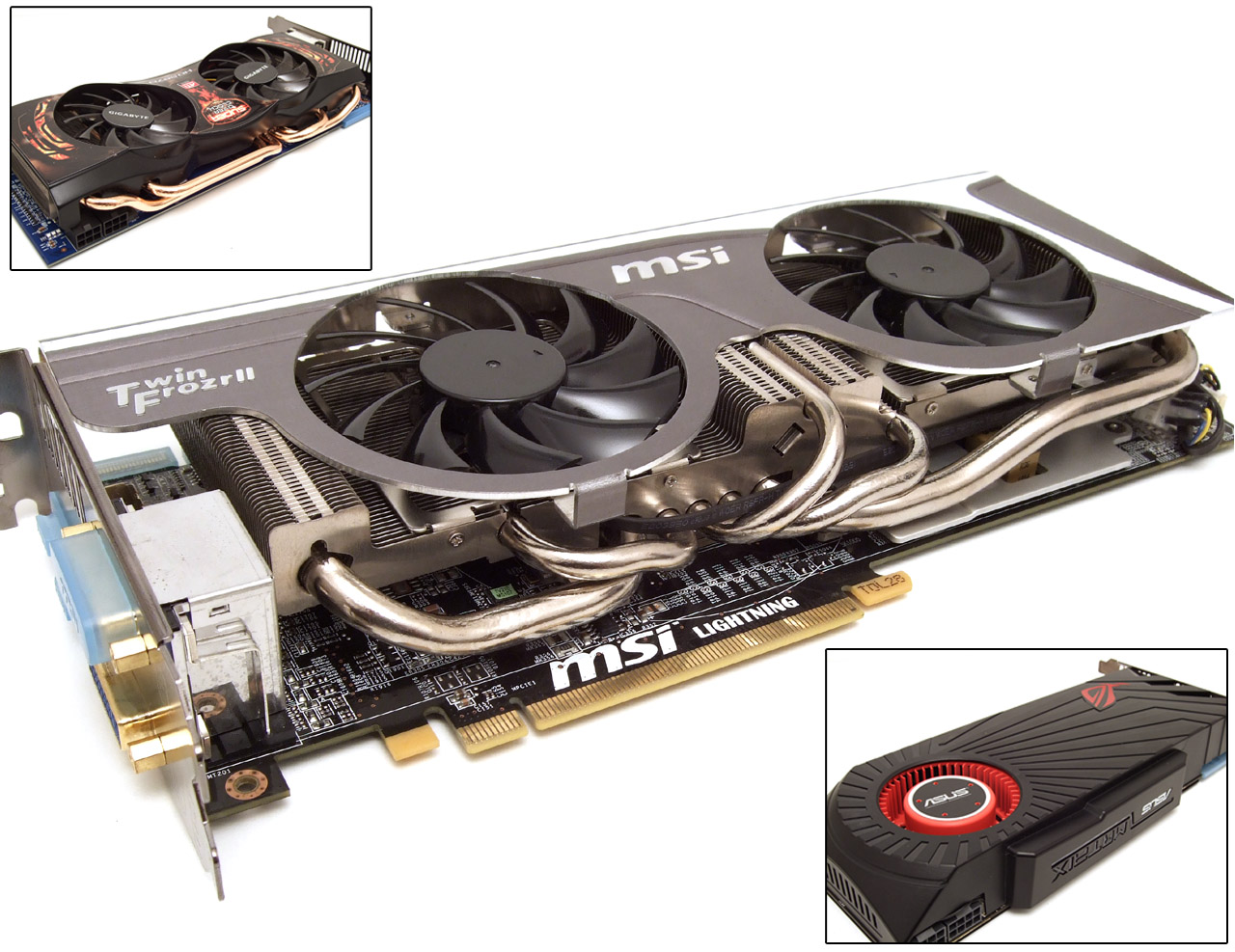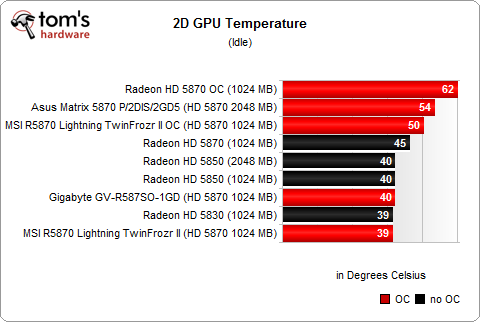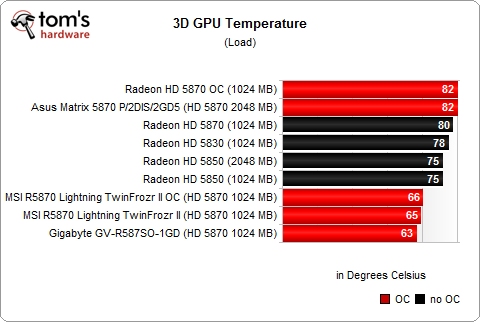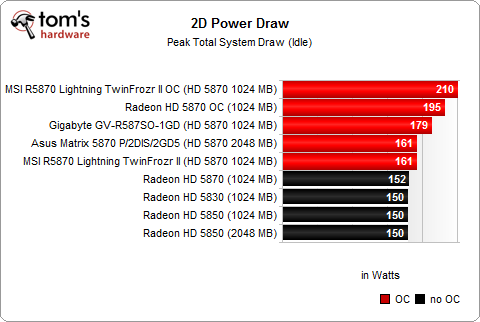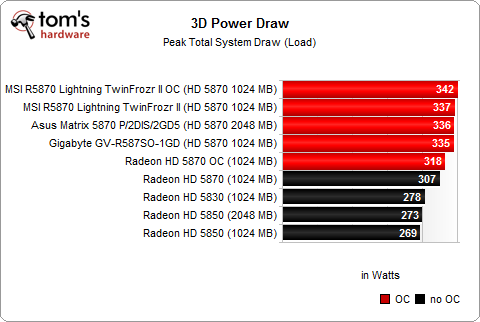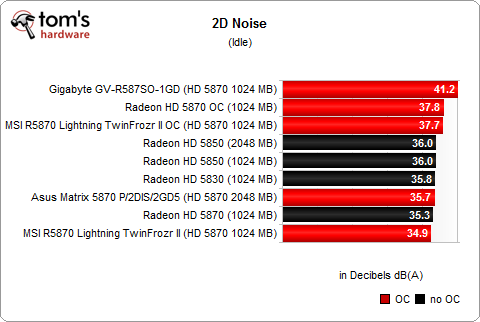Comparison: Factory-Overclocked Versus Reference Graphics
In order to set their products apart, third-party vendors take reference GPUs from AMD and Nvidia, then make their own tweaks to layout, cooling, and performance. We're comparing a tuned-up card from MSI to AMD's reference Radeon HD 5870 to measure value.
Cross-Check
We decided to run a few additional tests with several other, factory-overclocked graphics cards because we wanted to be sure that the results we’ve been seeing on MSI’s R5870 Lightning TwinFrozr II would apply to other boards with aftermarket enhancements as well. The two other cards also reduce clock speeds at idle, so long as they operate at their preset clock speed settings--we can be sure because the GPU temperatures stay below 45°C.
A quick look at the temperatures under 3D load make clear which cards are based on AMD’s Radeon HD 5870 reference design. All cards that reach 75°C or more are based on the same layout and cooling. The dual-fan solutions are in between 63 and 66°C.
The higher you overclock the graphics card, the more power will be required, even in 2D, as the cards don’t throttle clock speeds all the way down to where they would end at factory clock speed settings.
The 3D power consumption results also show very obviously which cards were factory-optimized for higher clock speeds. Most factory-overclocked cards run at slightly increased GPU voltage to maximize reliability, which adds an additional ~20 W to the total power consumption on these systems.
You don’t need fast fan speeds if the graphics card throttles clock speeds at idle. Card vendors that do the best job optimizing fan speed stay below 36 dB(A).
3D peak loads reveal the differences between reference cooling and the optimized products: it’s high air flow and noise versus optimized power and low noise. In an ideal case, overclocked graphics cards with optimized cooling solutions aren’t any louder than reference cards at reference speeds. If a factory-overclocked card goes for fast fan speeds right away, then you can be sure that it prepared the product for serious overclocking.
Get Tom's Hardware's best news and in-depth reviews, straight to your inbox.
-
rohitbaran Too less performance gain (4-5 FPS) for the too much extra price paid ($50-$70) along with too much increase in power consumption (30-40 W. Better to buy a reference card unless you want the best no matter what the price is.Reply -
Mark Heath I like the idea behind the article and I'm glad that there's been some testing done on it, but I don't really like the article itself.Reply
There are references to how much the reference card is overclocked by, but there is no clear section about it, you started off with some of the summary charts, instead of putting them after the initial tests and you kept switching what cards you were comparing, with less warning than I would like..
Plus there's that 2GB 5850. Is that really a 2GB 5850, or is it actually 2GB 5830, because it kept getting beaten by the 1GB 5850..
-
Onus When I buy a new GPU, I look for one who's reference clocks make it "good enough" as-is; but I do look for a better / quieter cooler.Reply -
mrhoshos96 great article but u should have compared the reference against the sapphire vapor-xReply -
Tesla1483 ReplyIn order to their products apart, third-party vendors take reference GPUs...
I'm guessing they meant "In order to SET their products apart..."
Seriously, it's the first sentence in the article. Does no one proof read anything here? Isn't that like the first thing you learn when you want to become a writer? Sorry, rant over. -
youssef 2010 "This cooling concept works pretty well, as it not only provides effective graphics component cooling, but it also helps to remove warm air from the inside of your PC. "Reply
The reference 5870 has a vent on its side so, it doesn't completely remove the hot air from the case but recirculates a part of the hot air back into the case -
duk3 It's a 5850, look how close the framerates are.Reply
The amount of ram doesn't really matter at these resolutions. -
LLJones The cards just do not offer enough gain. If you can afford the overclock edition at a premium, then save up a little more and get the next card up or buy two of the next lower cards. The $1000+ dual 5870 from Asus shows what a complete waste of money some, not all, super OC cards are.Reply
Try this, put together a really really really premium card component wise, and then don't put any cooling on it. Let me decide what I am going to do for cooling and companies can save on packaging, shipping etc due to no cooler.
If your really aiming at the OC crowd and not just playing a game of marketing, then you know the first thing someone does is to rip off your factory cooler to replace it or at the very least put quality thermal compound on it.
